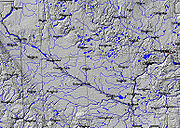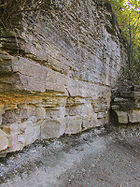
River Warren Falls
Encyclopedia

Glacial River Warren
right|thumb|210px|The course of the Minnesota River follows the valley carved by Glacial River WarrenGlacial River Warren or River Warren was a prehistoric river that drained Lake Agassiz in central North America between 11,700 and 9,400 years ago...
initially located in present-day Saint Paul, Minnesota
Saint Paul, Minnesota
Saint Paul is the capital and second-most populous city of the U.S. state of Minnesota. The city lies mostly on the east bank of the Mississippi River in the area surrounding its point of confluence with the Minnesota River, and adjoins Minneapolis, the state's largest city...
, United States
United States
The United States of America is a federal constitutional republic comprising fifty states and a federal district...
. The waterfall was 2700 feet (823 m) across and 175 feet (53 m) high.
Geologic history
The area now occupied by the Twin Cities generally consisted of a 155 foot (47 m) thick layer of St. Peter SandstoneSt. Peter Sandstone
The St. Peter Sandstone is an Ordovician formation in the Chazyan stage of the Champlainian series. This sandstone originated as a sheet of sand in clear, shallow water near the shore of a Paleozoic sea and consists of fine-to-medium-size, well-rounded quartz grains with frosted surfaces...
, under a 16 foot (5 m) thick layer of shale
Shale
Shale is a fine-grained, clastic sedimentary rock composed of mud that is a mix of flakes of clay minerals and tiny fragments of other minerals, especially quartz and calcite. The ratio of clay to other minerals is variable. Shale is characterized by breaks along thin laminae or parallel layering...
, under a 35 foot (11 m) thick layer of Platteville limestone
Platteville Limestone
The Platteville Limestone is the Ordivician limestone formation in the sedimentary sequence characteristic of the upper Midwestern United States. It overlies the thin Glenwood Shale, which overlies the thick Saint Peter Sandstone...
. These layers were the result of an Ordovician Period sea which covered east-central Minnesota 500 million years ago. The hard limestone cap was formed from fossilized shell fish. About 20,000 years ago, the area was covered by the Superior Lobe of the Laurentide ice sheet
Laurentide ice sheet
The Laurentide Ice Sheet was a massive sheet of ice that covered hundreds of thousands of square miles, including most of Canada and a large portion of the northern United States, multiple times during Quaternary glacial epochs. It last covered most of northern North America between c. 95,000 and...
, which left the St. Croix moraine
Moraine
A moraine is any glacially formed accumulation of unconsolidated glacial debris which can occur in currently glaciated and formerly glaciated regions, such as those areas acted upon by a past glacial maximum. This debris may have been plucked off a valley floor as a glacier advanced or it may have...
on the Twin Cities as it receded. Later the Grantsburg Sublobe of the Des Moines Lobe also covered the area. Under these vast layers of ice, tunnel valley
Tunnel valley
A tunnel valley is a large, long, U-shaped valley originally cut under the glacial ice near the margin of continental ice sheets such as that now covering Antarctica and formerly covering portions of all continents during past glacial ages....
s were formed, cutting through the limestone layer with tremendous force, to release ice meltwater and glacier effluence. The result was a series of troughs in the limestone, which were filled by glacial till and outwash deposit as the glaciers receded. Sometimes the sediment would be mixed with huge chunks of ice, which would leave voids in the soil, or kettles. These kettles created basins for the Twin Cities Lakes, such as Harriet and Calhoun
Lake Calhoun
Lake Calhoun is the biggest lake in Minneapolis, Minnesota, and part of the city's Chain of Lakes. Surrounded by city park land and circled by bike and walking trails, it is popular for many outdoor activities...
. Connecting the city lakes in several north-south arteries are gorges cut through the bedrock, but filled with sand and sediment.
Glacial River Warren

Minnesota River
The Minnesota River is a tributary of the Mississippi River, approximately 332 miles long, in the U.S. state of Minnesota. It drains a watershed of nearly , in Minnesota and about in South Dakota and Iowa....
currently runs in the valley created by the River Warren. When the river reached present-day St. Paul, the massive volume of water quickly washed out the till, sand, gravel, and sedimentary rock that had filled one of the troughs. The result was the Warren River Falls, plunging 175 feet (53 m) into a deep gorge. The turbulence caused by huge volumes of falling water washed out the sandstone underneath the falls, causing the thin limestone layer to break off in chunks. By 10,000 years ago, the waterfall had moved upstream to the confluence of the River Warren and the Mississippi River
Mississippi River
The Mississippi River is the largest river system in North America. Flowing entirely in the United States, this river rises in western Minnesota and meanders slowly southwards for to the Mississippi River Delta at the Gulf of Mexico. With its many tributaries, the Mississippi's watershed drains...
, adjacent to present-day Fort Snelling. By 9400 years ago, it had receded another two miles (3 km) up to Nine Mile Creek. At that point, Lake Agassiz
Lake Agassiz
Lake Agassiz was an immense glacial lake located in the center of North America. Fed by glacial runoff at the end of the last glacial period, its area was larger than all of the modern Great Lakes combined, and it held more water than contained by all lakes in the world today.-Conception:First...
broke through the ice to the north and began draining via the Red River of the North
Red River of the North
The Red River is a North American river. Originating at the confluence of the Bois de Sioux and Otter Tail rivers in the United States, it flows northward through the Red River Valley and forms the border between the U.S. states of Minnesota and North Dakota before continuing into Manitoba, Canada...
to Hudson Bay
Hudson Bay
Hudson Bay , sometimes called Hudson's Bay, is a large body of saltwater in northeastern Canada. It drains a very large area, about , that includes parts of Ontario, Quebec, Saskatchewan, Alberta, most of Manitoba, southeastern Nunavut, as well as parts of North Dakota, South Dakota, Minnesota,...
. River Warren then ceased to flow, but was succeeded by the much smaller Minnesota River
Minnesota River
The Minnesota River is a tributary of the Mississippi River, approximately 332 miles long, in the U.S. state of Minnesota. It drains a watershed of nearly , in Minnesota and about in South Dakota and Iowa....
which drained a smaller watershed
Drainage basin
A drainage basin is an extent or an area of land where surface water from rain and melting snow or ice converges to a single point, usually the exit of the basin, where the waters join another waterbody, such as a river, lake, reservoir, estuary, wetland, sea, or ocean...
. It carried soil and sediment, but with much less energy than its predecessor. It was less able to transport those suspended materials, which precipitated out and left deposits. Eighty feet (24 m) of this alluvium
Alluvium
Alluvium is loose, unconsolidated soil or sediments, eroded, deposited, and reshaped by water in some form in a non-marine setting. Alluvium is typically made up of a variety of materials, including fine particles of silt and clay and larger particles of sand and gravel...
filled the river valley at Ft. Snelling, and 175 feet (53 m) were deposited at Saint Paul, refilling much of the gorge.
The hydrology of the oversized valley was first explained by General G. K. Warren in 1868. He made a detailed survey of the valley in his search for possible transcontinental railroad routes. Posthumously, in appreciation of this work, the glacial river that was the outlet of Lake Agassiz was named River Warren.
Minneapolis waterfalls
When River Warren Falls receded past the confluence of the much smaller Upper Mississippi RiverUpper Mississippi River
The Upper Mississippi River is the portion of the Mississippi River upstream of Cairo, Illinois, United States. From the headwaters at Lake Itasca, Minnesota, the river flows approximately 2000 kilometers to Cairo, where it is joined by the Ohio River to form the Lower Mississippi...
, a new waterfall was created where that river entered the much-lower River Warren. The new falls also receded upstream on the Mississippi, migrating eight miles (13 km) over 9600 years to where Louis Hennepin
Louis Hennepin
Father Louis Hennepin, O.F.M. baptized Antoine, was a Catholic priest and missionary of the Franciscan Recollect order and an explorer of the interior of North America....
first saw it and named St. Anthony Falls in 1680. Due to its value as a power source, this waterfall determined the location of Minneapolis. One branch of the river coming from the west, Minnehaha Creek receded only a few hundred yards from one of the channels of the Mississippi. Minnehaha Falls
Minnehaha Falls
Minnehaha Creek is a tributary of the Mississippi River located in Hennepin County, Minnesota that extends from Lake Minnetonka in the west and flows east for 22 miles through several suburbs west of Minneapolis and then through south Minneapolis. Including Lake Minnetonka, the watershed for the...
remains as a picturesque and informative relic of River Warren Falls, and the limestone-over-sandstone construction is readily apparent in its small gorge.

